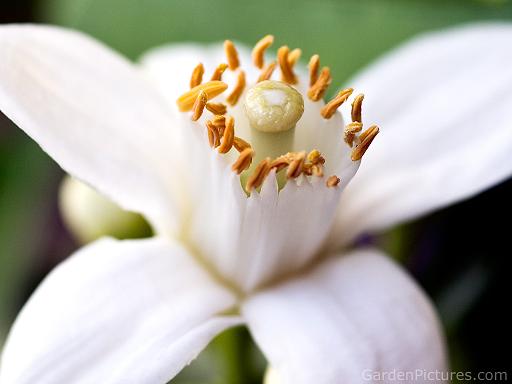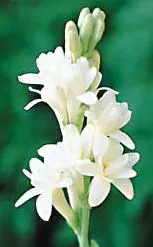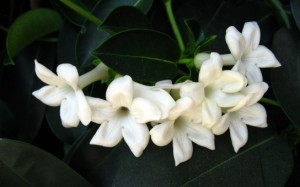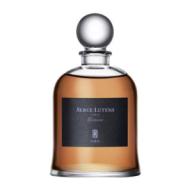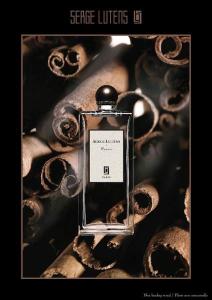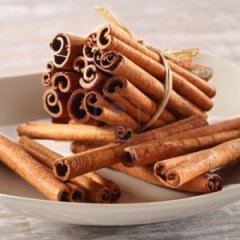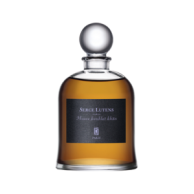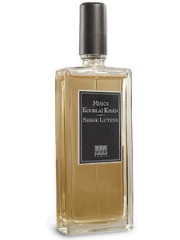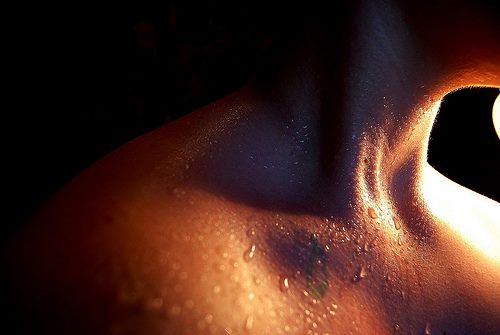One of my favorite aspects to Serge Lutens‘ line of perfumes is the dramatic, complex flair shown by many of them. Love them or hate them, his perfumes almost always have character. Once in a blue moon, however, you stumble across one that is, quite simply, dull. It’s hard for me because I can easily write reviews for perfumes I hate and for perfumes I love. Those that leave me utterly apathetic and unmoved are a whole other story, however. It’s even harder when you can see that it’s a well-made fragrance, but it just sits there for you. Serge Lutens’ Rousse was one of them: a somewhat strange perfume which actually had some nice parts but which, ultimately, felt banal. Cèdre is another, but it lacks even the benefit of strangeness to keep me somewhat on my toes. I’m so utterly apathetic, I can barely summon up the energy to describe it. So, here goes nothing….
Cèdre is an Eau de Parfum Haute Concentration that was created with Lutens’ favorite perfumer, Christopher Sheldrake, and released in 2005. On his website, Lutens compares the fragrance to a sort of woody pastry:
Like a pastry made of wood.
Another take on Féminité for an alternate reality. True to its name, it contains cedar, to which honey is the key. But I have added tuberose, barely perceptible but of paramount importance.
Strangely, Serge Lutens’ press release for the perfume (as quoted by the Belgian store, Senteurs d’Ailleurs) is a whole other, disparate tale, describing the felinity of a wildcat with steps of steel and the tenseness of a criminal proceeding:
The wildcat glides along, cautious and rhythmic with supple, velvety steps of steel. The forest watches…
A heavy, restless silence, a tense moment, similar to those preceding the jury’s verdict to condemn the accused, guilty or even the innocent…
A rich, woody, animalistic, soft fragrance… harmonises in full splendour with arrogant tuberose.
A strong musk blended with amber, clove and cinnamon adds the final touch to the regalia.
An irrevocable verdict for this essential, profoundly original fragrance….
The perfume notes — as compiled from Luckyscent, Fragrantica and the two Lutens statements — thereby seem to be:
Cedar, Tuberose, Clove, Cinnamon, Honey, Musk, and Amber.
Cèdre opens on my skin as a boozy, rummy, ambered fragrance. It is a potent blast of cinnamon apple pie, raisins, and dried, purple, stewed fruits with subtle flickers of dark smokiness and a dash of cloves, atop a base of sugary brown syrup. The cedar note dances hazily in the background, muted and really minor in the overall scheme of things. It’s more like an amorphous woody element that never feels like peppery cedar but, rather, like something simply dry, spicy and lightly smoked. Moments later, a delicately floral tone creeps in, but it’s not immediately distinguishable. Like the cedar, it’s muted, hidden, indistinct, and strongly imbued by a heavy, dense sweetness that feels like honeyed molasses mixed with a slightly buttery, caramelized, brown sugar.

Source: Talk of Tomatoes. (Click on photo to go to website with its recipe for rum, plum, cardamom jam.)
To me, Cèdre immediately calls to mind Jean-Claude Ellena‘s Ambre Narguilé with its strong rum raisin, stewed fruits, and smoky accord. The similarities are inescapable, though Cèdre is stronger, richer and denser in both feel and potency. It is so highly concentrated in its opening moments, in fact, that I initially wondered if I had applied too much as something about it made me head throb. It almost felt as though there were small touches of ISO E Super in the base, lurking around and adding to the velvety, creamy undertones of the fragrance.
The floral note in Cèdre really bewildered me at first. Nothing about it smells like tuberose to my nose. Actually, it smells a hell of a lot like immortelle! I tried Cèdre twice, and both times, I had the same impression. The note has the same dry, slightly woody, vaguely herbal feel of immortelle’s flower, along with that subtle maple syrup nuance that can characterize the flower. The aroma wafting off my skin is absolutely nothing like tuberose with its very indolic, ripe, voluptuously fleshy whiteness. It’s not even like a Lutens/Sheldrake take on tuberose with its sometimes chilly, metholated nuance. Nope, at no time do I smell tuberose in Cèdre. It’s my favorite flower and, if you put a gun to my head and demanded that I find tuberose in Cèdre, I still wouldn’t or couldn’t do it. As you will soon see, others have a totally different experience.
Ten minutes into Cèdre’s development, it is a boozy, rummy, plummy, raisin fragrance with spices, flickers of incense smoke, sugary sap, muted woods, and hints of some dry, masculine floral. There is a growing sense of something creamy in the base, as well as something a little bit animalic. It’s not dirty, skanky, or raunchy, but there is a leathery, musky undertone that slinks around the background. Twenty minutes in, the perfume’s edges turn soft and blurry, becoming a well-blended mix of notes without any sharp delineation. The most individually distinct element that I can pull out of the mix is boozy rum raisin, but the rest seem to overlap and melt into each other.
As time passes, the creaminess and smoothness of the bouquet grows, as does its hazy feel. At the forty minute mark, the rum raisin accord in the foreground is replaced by an abstract, plummy, spiced sweetness. The perfume’s background notes are tinged with amber and with a subtle smokiness that feels nutty, sweet, warm and resinous. Wafting all around, like a subtle shadow, is that vague floral note with its herbal, woody, dry, syrupy feel. Ergo, immortelle.
Cèdre gets blurrier by the minute. At the end of two hours, it’s an abstract swirl of sweet, lightly spiced woodiness with amber, smoke, and some nebulous floral hints. There is a subtle feel of something honeyed, musky and faintly leathery in the base that makes me think that the “amber” must include some labdanum. The whole thing just barely hovers above the skin. Around 3.5 hours in, Cèdre is an abstract amber that feels veiled with honey and a touch of cinnamon. The muskiness grows more pronounced, such that, midway during the fifth hour, the perfume is merely sweet, ambered, labdanum musk with a leathery undertone and a hint of spices. Cèdre remains that way until its final moments, 7.25 hours from its start, when it is nothing more than a trace of musky amber.
Months from now, whenever I think of Cèdre, I have no doubt that the only description I shall be able to conjure up is “blurry Ambre Narguilé.” In fact, I shall be hard-pressed to recall its details in a few days from now, let alone in the weeks and months to come. That says something about a fragrance — and it’s not good. I suspect I shall recall far more how a vast number of people find Cèdre to be a tuberose fragrance. Because they really do. Tons of them, in fact!
My favorite review of Cèdre comes from One Thousand Scents whose opening paragraph made me laugh for a good ten minutes the other day. I think it’s the tone of indignant outrage that does it, along with the characterization of Serge Lutens himself:
If you are a normal person and you are going to make a perfume called Cèdre, which is the French word for cedar, then by god you are going to make a cedary scent, something that puts the spotlight on the wood. If, on the other hand, you are Serge Lutens, which is to say by definition you are not a normal person, then you are going to make a big, wild-eyed tuberose scent and confuse the hell out of everyone.
I’m laughing all over again. As for the perfume itself, he admires Cèdre on an intellectual basis, but he seems to truly hate the smell itself:
The opening is an explosive tuberose, kind of dirty, with a weird toothpasty quality–toothpaste without the mint in it. There is a faint burning spice in there, although really nothing could survive the onslaught of tuberose sweetness. The sweetness is key, because this doesn’t have that harsh, screechy edge that tuberose so often has for me, and that’s the only reason I could sample this and not desperately want to scrub it off. Even so, it’s kind of cloying; it keeps coming at you, demanding to be noticed.
Eventually the floralcy, though not the sugar, begins to die down a little, and the cedar finally sidles into view, with the faint ribbon of wood smoke that cedar so often carries. This is very nice, and it lasts a very long time.
Cèdre for me works less as a scent than as an intellectual experiment, an essay in cognitive dissonance: what you read doesn’t match what you smell, and what you smell is two extremely disjunct things forced into harmony. I could never wear it, that’s for sure.
On Fragrantica, people’s impressions of Cèdre largely seem to fall into four categories: those who think it’s mostly just a cedar fragrance; those who think it’s almost all tuberose; those who think that the two notes are in a perpetual tug of war for hegemony; and those who think it’s actually an amber fragrance. The main note in the perfume, according to 92 people, is tuberose. Amber comes in next with 65 votes, while cedar is in third place with 58. One commentator said Cèdre began with “[a] very aggressive tuberose opening on me. It smelled very heavy, greasy, sexy, almost obscene!” The note left after 10 minutes on her skin, never to return, but, for another, Cèdre was almost all tuberose:
The name Cedre can be a little misleading. Surprisingly this is a soapy and elegant tuberose fragrance, with a spicy and woodsy drydown. The cedar note is barely evident in this fragrance’s composition, so don’t go expecting any masculine woodsiness while testing Cedre.
For many commentators, however, things are not so black and white, and Cèdre is a mix of things, sometimes dominated by amber. Two examples:
- This was not what I had expected from a perfume named ‘Cedre’. The opening notes were a clash of cloves and cedar and for a few minutes it seemed these two were playing out some sort of war of attrition. I wasn’t sure who would win. This was a fleeting phase and shortly they both settled to allow the amber, cinnamon and tuberose rise from the battlefield. Oh wow. This is good stuff. It has the classic Lutens DNA but the tuberose gives this an ethereal quality that seems to give these rich notes a lighter touch. As I write this, the tuberose is developing a wonderful animalic note.
- Cedre is a rich amber fragrance opening with cinnamon and labdanum. It contains that signature Lutens rich amber “hum”, though the intensely resinous cedar like the living tree, or freshly chopped firewood in the composition gives it clarity, preventing it from turning into a syrupy mess. It’s more like a wood-burning stove baking up fresh cinamon buns. [¶] Cedre has an effervescent quality like an artisan-crafted all-natural birch beer, and the labdanum makes the sweetness smooth, warm, and wearable. It is a basket of sweet and spicy offerings from the forest floor to the canopy. It is the sweetness found naturally in forest air, distilled. [¶][…] This may be my favorite gourmand to date.
Many bloggers seem to be divided into the camps listed above. For Robin at Now Smell This, Cèdre was an amber fragrance with an opening blast of tuberose that was initially mentholated (as in Tubereuse Criminelle), but whose floral nature was eventually muted by woodsy, honeyed amber notes that had a subtle animalic, leathery flicker in the base. She found the cedar itself to be “surprisingly subdued; it is a very woody fragrance but it has none of the sharp edges I commonly associate with cedar.” Yet, she could also see how a friend of hers would think Cèdre was all about spiced apple, which is what I got, too. As a whole, Robin was ambivalent about the fragrance since, the first few times she tried it, “it was too much sweet amber and too little cedar and tuberose,” but she could see it growing on her.
Tuberose, and Lutens’ Tubereuse Criminelle, were also on the mind of the PeredePierre whose review begins by saying that the release of Cèdre was a surprise because “[w]hat no one was expecting [was]… a tuberose-laden scent with only the slightest hint of anything woody.” Calling Cèdre “a challenging composition,” he writes:
Cedre starts off with a powerful, mentholated camphor note. Not nearly as shocking as Tubereuse Criminelle, but still quite the sucker-punch. Immediately evident are the spices – clove, cinnamon, and the usual suspects for a Lutens fragrance. Tuberose is clearly the main player in the scent from the beginning, although it softens somewhat as things progress. Cedar does makes its way in eventually, although not nearly enough to warrant a star-spot in the perfume’s title. Cedar’s typical raspy character is felt more than any obvious woody presence.
The drydown reveals something much more interesting though – a dirty musk! Up until that point, things are a bit cloying, a bit on the sweet side, and very much full of clove (not my favourite thing in the world), but the musk note is an intriguing touch.
Over at Perfume-Smellin’ Things, Marina prefers Lutens’ Bois Oriental, finding Cèdre to fall short in comparison. She find it to be “pleasant,” in a review that essentially damns Cèdre with faint praise:
Sweet-ish woods, lovely almost imperceptible tuberose, a tiny dash of cinnamon. Every note is understated, muted, almost demure. Rich and animalistic? Absolutely not. Soft? Definitely. Also, I must say, rather unremarkable. Cèdre is one of those neutral, elegant, “politically correct” scents that are appropriate anywhere, anytime.
The Non-Blonde adores Cèdre, but she notes how many people find it to be far from the cedar fragrance that they had expected:
When Cedre came out in late 2005, many people were somewhat bewildered. They expected Uncle Serge to treat the cedar note in a similar way he stripped oak a year before when he created Chene. Instead of a glorious dry tree, they found themselves sampling a boozy, sweet, ambery oriental perfume with a creamy tuberose in the middle.
Which, of course, is exactly why I adore Cedre.
It radiates. From the sweet opening to the sweeter drydown, this is one weird scent. It takes you on a trip to places where otherworldly things grow. There’s apple-free cider, radioactive cinnamon, clove that doesn’t bite and wouldn’t remind you of the dentist, wood that glows in the dark, white flowers that disappear and pop out again and black honey. It’s a carnival and can get quite big and noisy, but on my skin it’s heaven.
All the bloggers seem to have experienced a fragrance that was profoundly more interesting than the muted, slightly abstract, boozy, rum raisin, spiced amber that manifested itself on my skin. I love those notes, but something about Cèdre’s composition was neither original nor dramatically edgy. I think it was the muffled, murky, blurry aspect to the notes. Had they been more sharply pronounced and distinct, I might have felt much less bored by the amorphous swirl of ambered stewed fruit. Or, perhaps not. It’s not as if there aren’t half a dozen rummy, boozy ambers already out there…..
I don’t know what to say to you in terms of recommendations. Those who hate tuberose — and Tubéreuse Criminelle, in specific — should probably stay away from Cèdre, but then, what happens if it’s all dense, rich, spicy amber without even a hint of tuberose? Or a pure cedar fragrance that evokes a “wood-burning stove baking up fresh cinamon buns” and whose base feels infused by a subtle gourmand sweetness? Perhaps you’d love it. The problem is, I have no idea what may show up on your skin.
If it’s any use or guidance, a number of people on Fragrantica compare Cèdre to Amouage‘s Memoir Woman, while on Basenotes, I’ve read a lot of comparisons to how Cèdre has the same vibe as Histoires de Parfums Tubéreuse 3 – Animale. I haven’t tried Memoir Woman yet, but my recollection of briefly testing Tubéreuse 3 is that it was a significantly more leathery, difficult, dry, immortelle-based fragrance at its start. Though it’s supposed to be a similar take on a masculine tuberose, I didn’t leave Tubereuse 3 on my skin long enough to get to that part. What I did smell was mostly an immortelle fragrance with leather, tobacco and pungent, dry hay. In short, something very different to the Ambre Narguilé vibe I get from Cèdre. (That said, it’s odd how the only floral that showed up for me in Cèdre is something that feels like a muted immortelle, but absolutely nothing that smells like tuberose.)
If my personal tastes or thoughts are of any help, I wouldn’t bother with Cèdre. It leaves me completely cold — and this comes from someone who loves both Lutens, and boozy, spicy amber fragrances in general. In fact, Cèdre triggers so much apathy and disdain that writing a long review about it has resulted in feelings that almost verge on the hostile for the poor fragrance. So, I shall end this review here and now.








